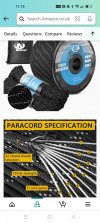Hi guys
A bit confused so maybe someone can share their experience.
The other day I was cutting some paracord for garden project and after literally few cuts I noticed reflective spots on my blade....bit confused and disappointed....I grabbed few of my knives in different steels (3v, Aebl, 52100, k390) and started to use them.
Same effect.... literally after two or 3 push cuts through paracord edge gets dull .
.
I sort of accept that nylon is abrasive but I wasn't expecting that effect even on high end steels.
I thought to myself, maybe it's the issue with my sharpening and I just got wire edges, but I used my spyderco k390 with still factory edge (apart of light stropping) and effect is the same.
Checked the paracord and it is heavy duty one but apart of that just the normal product.
Is that your experience as well?
A bit confused so maybe someone can share their experience.
The other day I was cutting some paracord for garden project and after literally few cuts I noticed reflective spots on my blade....bit confused and disappointed....I grabbed few of my knives in different steels (3v, Aebl, 52100, k390) and started to use them.
Same effect.... literally after two or 3 push cuts through paracord edge gets dull
I sort of accept that nylon is abrasive but I wasn't expecting that effect even on high end steels.
I thought to myself, maybe it's the issue with my sharpening and I just got wire edges, but I used my spyderco k390 with still factory edge (apart of light stropping) and effect is the same.
Checked the paracord and it is heavy duty one but apart of that just the normal product.
Is that your experience as well?

